Explore the Ultimate Football Destinations in Europe
It’s no secret that Europe is home to some of the best football in the world. Top leagues such as the Premier League, the Bundesliga, La Liga, and other globally renowned leagues are based in Europe. It’s also the home of the UEFA Champions League, Europa League and Europa Conference League, and thanks to the plethora of incredible footballing cities, the Euros are held every four years, and Europe has also hosted 12 World Cups since 1930.
But what makes these European cities the best for football fans? Below, we have organised the cities by several criteria, ranging from stadium capacity to historical significance and more. Read on to find out all about the 20 best European cities for football fans.
Explore the Ultimate Football Destinations in Europe
This ranking is based on 6 criteria.
- Record Attendance: This is not necessarily the stadium capacity, but instead the record attendance at a match at that particular football ground.
- Loudest Stadiums: Some stadiums generate incredible atmospheres thanks to the sheer noise made by fans – and this is a criterion we have used to rank some of these stadiums and their home cities.
- Historical Significance: Some of the cities have rich and varied histories, and this translates through to the football teams, who often honour and represent this history through their stadiums, kits and community work.
- Fan Culture & Cultural Impact: Some clubs have incredibly passionate and loyal fanbases, while other fanbases are built around certain beliefs and culture – these all play a part in the city’s heritage as well as the football clubs'.
- Accessibility: Is the stadium near any good public transport links, and how accessible is it for fans with restricted mobility issues?
- Average Ticket Price: We will look at the average price of a ticket at each stadium for this criterion, with tickets under £40/€40 being classed as a good price.
20. Dortmund, Germany
One of the best cities for European football fans has to be Dortmund. Home to Borussia Dortmund’s iconic Signal Iduna Park, and the world-famous ‘Yellow Wall’, which has a capacity of 25,000 Dortmund fans sitting behind the goal, a trip to go and watch Borussia Dortmund has to be on the bucket list of any European football fan.
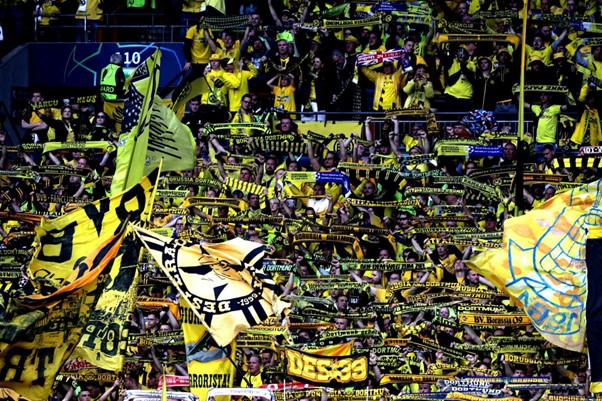
Located in north-western Germany, the city of Dortmund has plenty on offer other than football – sample some excellent German food before getting to the Signal Iduna Park to watch Dortmund compete in the Bundesliga, Germany’s top division. Dortmund contest ‘Der Klassiker’ – their derby match with 32-time Bundesliga champions Bayern Munich, and it is one of the biggest matches in Germany without question.
Borussia Dortmund’s stadium is easy to reach by public transport and also has over 10,000 car parking spaces available for those who have driven there. Borussia Dortmund are also home to some of the cheapest matchday tickets in Europe, with standing tickets starting from just €18.50 (£15.46), making a day out to the Signal Iduna Park a must-visit for any football fan.
Record Attendance: 80,520 (25th May 2013, vs Bayern Munich)
Stadium Capacity: 81,365
19. Milan, Italy
Another huge footballing nation, Italy is home to some football-mad cities, including Milan. Milan is also fairly unique in the fact that it is home to two fierce rivals (AC Milan and Inter), who share the same stadium: the San Siro.
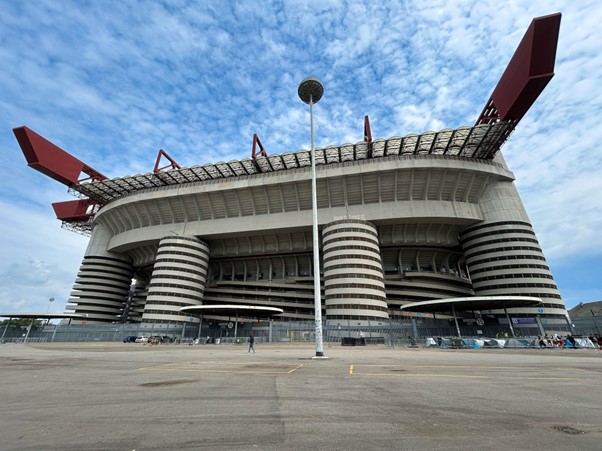
This iconic stadium, with its spiralling staircases, is a must-visit for any football van visiting Milan. Hosting league matches in Serie A, and often both teams competing in either the Europa League or the Champions League, as well as international games where Italy are often the host nation, visiting the San Siro is a rite of passage for football fans from all over the globe.
The city of Milan is easily accessible from the stadium, and with its very own train station, the stadium is equally as accessible from the city itself. Exploring the traditional Milanese architecture before a game, and visiting one of the city’s best bars after the game makes for an excellent day trip to this northern Italian city.
Record Attendance: 83,381 (21st May 1997, Inter vs Schalke 04)
Stadium Capacity: 80,018
18. Lisbon, Portugal
The capital of Portugal is a fantastic city to visit for tourists, regardless of their interests, but is particularly good for football fans. Home to two of Portugal's ‘Big Three’ football teams (Benfica and Sporting CP – the other being Porto), Lisbon is a historically rich city filled with passionate football fans.
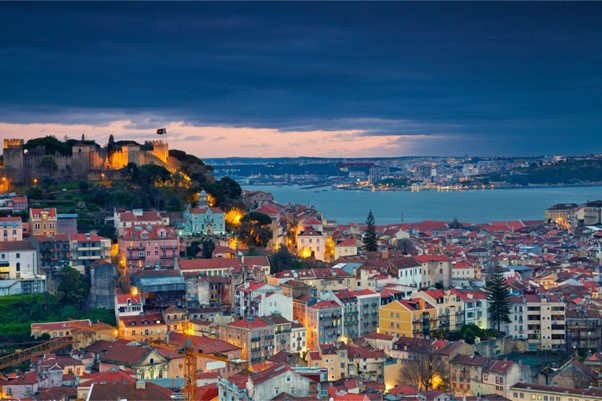
Visitors to Lisbon have the choice of which of the city’s two incredible stadiums to visit. Tickets to Benfica are generally cheaper than Sporting CP, usually around €50 (£41.80), and it’s a fact that the quality of football will always be of the highest standard at either Benfica or Sporting CP.
Lisbon itself, while hilly, is easily accessible, even for those with mobility issues. Both stadiums have strong public transport links nearby, making them ideal to visit even if you have not hired a car for your Lisbon trip.
Record Attendance: 64,519 (13th May 2017, Benfica vs Vitória de Guimarāes); 50,046 (22nd November 2016, Sporting CP vs Real Madrid)
Stadium Capacity: 64,642 (Estádio do Benfica); 50,095 (José Alvalade Stadium)
17. Marseille, France
Located on the south coast of France, and the largest city on the French Riviera, it’s no surprise that Marseille is a popular destination for holidaymakers across the globe. However, it is also one of the best European cities for football fans to visit for a number of reasons.

Playing in Ligue 1, France’s top division, Marseille has a tradition of great players, both French and foreign. World Cup winners Didier Deschamps, Marcel Desailly, Fabien Barthez and Laurent Blanc all played for Marseille, and their ability to attract huge names to the club has worked to Marseille’s advantage over the years.
The Orange Vélodrome, Marseille’s stadium, is one of the newest stadia in France, formally opening in 2016 – and the new feel of this stadium goes hand in hand with the club’s values in a modern and inclusive environment. Marseille recently wore rainbow shirts to raise awareness about the struggles that LGBTQ+ football fans can be subject to.
Marseille itself is a wonderful city – perfect for a romantic break, or simply to visit the stunning architecture which the French Riviera is so well known for. Just walking around the city makes for a fantastic day out, and there’s plenty to see and do in Marseille to spend some time getting to know your surroundings before watching a match at the Orange Vélodrome.
Record Attendance: 65,894 (26th February 2023, vs Paris Saint-Germain)
Stadium Capacity: 67,394
16. Valencia, Spain
However, for football fans, it’s simply a must-visit destination. Home to one of the giants of Spanish football, Valencia CF, who have six La Liga titles under their belt and contest a derby with Barcelona, Valencia is an excellent destination for any fan of Spanish or European football.

Valencia’s fans are known for being some of the most dedicated in world football, regularly following their team not just all over Spain, but throughout Europe, when the team competes in competitions such as the Champions League or the Europa League.
And even if you cannot manage to get tickets to a Valencia game, you can still watch two of the other football teams who play in the city of Valencia: Villareal (who also compete in La Liga), or Levante UD (who compete in Spain’s Second Division). And while you’re in Valencia, why not take the opportunity to take in some of the city’s culture?
Record Attendance: 47,794 (26th November 2017, vs Barcelona)
Stadium Capacity: 49,430
15. Istanbul, Turkey
A city that spans two continents, Istanbul is one of the most historically significant cities in the world. A trading hub since the Ancient Greek period, Istanbul’s geographic location between Europe and Asia has made it a popular city for tourists from all over the world.
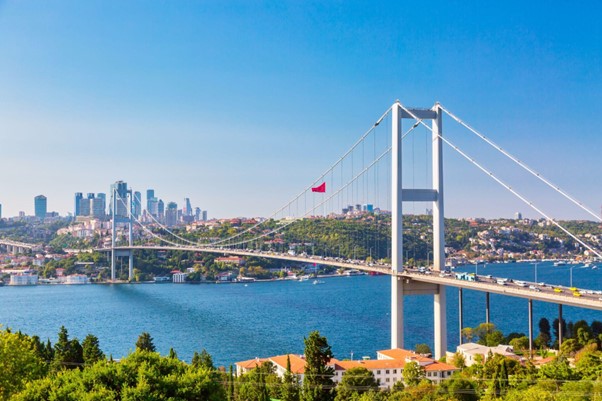
However, it’s Istanbul natives who have put their city firmly on the global football map, thanks to their intense derby matches from two warring factions in the city: Galatasaray and Fenerbahce. These fierce rivals contest the Intercontinental Derby, which is deemed the biggest match in Türkiye, and arguably the biggest derby game in world football.
Fans can expect an intimidating atmosphere at the Intercontinental Derby, with flares, music and more creating an intense atmosphere for any neutral watching. There are lots of other matches in the Turkish league which are far less intense, but the fans are equally as passionate about their teams.
Istanbul is also a fantastic city, steeped in culture and history spanning back thousands of years. The trading history of the city is still heavily represented today in the Grand Bazaar, so if you need to do any last-minute shopping before the match, make sure you pay a visit to the city’s biggest shopping centre.
Record Attendance: 53,792 (Galatasaray vs Bayern Munich, 19th May 2024); 44,283 (Fenerbahce vs Galatasaray, 21st September 2024)
Stadium Capacity: 53,798 (Rams Park, Galatasaray); 47,544 (Sükrü Saracoglu Stadium, Fenerbahce)
14. Rome, Italy
Just across the Adriatic and into the Mediterranean, the next stop on our list is one of the most famous cities in the world: Rome. Home to the mighty Roman Empire and seat of the Catholic Popes for almost 2,000 years, Rome is a city rich in history, culture, food, drink – and football.

Two giants of Serie A, Italy’s top flight, compete in the all-Roman derby: Roma and Lazio. These bitter rivals test each other at least twice a season, sometimes more if they come face-to-face in the Champions League or the Europa League, and they are also generally at the top end of Serie A, fighting for the Italian league title.
Similarly to the Milanese teams, Roma and Lazio share a stadium – Stadio Olimpico – so football fans are spoiled for choice when visiting Rome, as to whether they want to watch Lazio or Roma play, or if they’re there for long enough, perhaps even watching both of them play. And this is affordable to do so – tickets start from around €30 (£25.06) for both Roma and Lazio matches.
The stadium itself can be reached easily whether via car, bus, subway or train throughout Rome, and there are several public transport stops just metres from the stadium’s entrance, making it easy to access for all football fans.
Of course, there’s plenty to do in Rome before watching a match at the Stadio Olimpico – from eating authentic Italian cuisine to visiting the Colosseum (one of the New Seven Wonders of the World), check out our exclusive Rome guide here.
Record Attendance: 78,886 (12th May 1974, Lazio vs Foggia)
Stadium Capacity: 70,634
13. Barcelona, Spain
Another incredible city to visit on the Mediterranean coast is Barcelona. Situated in Spain’s Catalonia religion, the Barcelona (or Barca) fans are some of the most passionate fans in Spain. The club itself has been home to some of the best players in the history of the game: Lionel Messi, Andreas Iniesta, Xavi Hernandez, Johan Cruyff, Thierry Henry, Carles Puyol and Sergio Busquets to name just a few of the many world-class footballers who have represented Barcelona at one time or another.
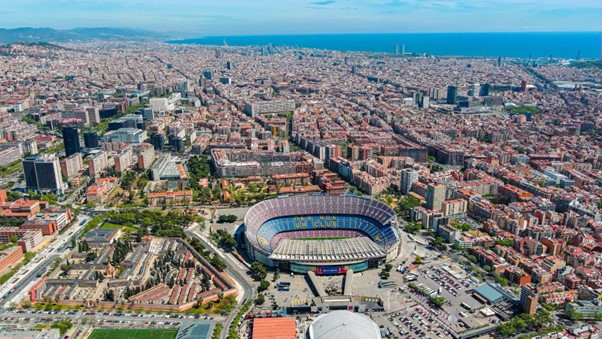
The stadium – the legendary Nou Camp – is currently undergoing some renovations to make it even more spectacular than it already is, so for the time being Barcelona are playing their matches at the Barcelona Olympic Stadium. The renovations to the Nou Camp are expected to be completed by August 2026, when the stadium capacity will increase to 105,000, as well as offering 4,000 car parking spaces underground. This will make it the second-largest football stadium in the world, just behind the 114,000-capacity Rungrado 1st May Stadium in North Korea.
Barcelona is a wonderfully cultural city, and the residents are proud Catalans – it’s almost impossible to find supporters of any other football team than Barcelona when speaking to the city’s residents. From iconic sites such as the Sagrada Familia and Park Güell, Barcelona is home to more than just football – and makes for the perfect place to spend a weekend.
Record Attendance: 120,000 (vs Juventus, 5th March 1986)
Stadium Capacity: 105,000 (following renovations)
12. Glasgow, Scotland
Home to the two biggest teams in Scotland – Celtic and Rangers – Glasgow’s ranking as one of the best European cities for football fans is well-deserved.
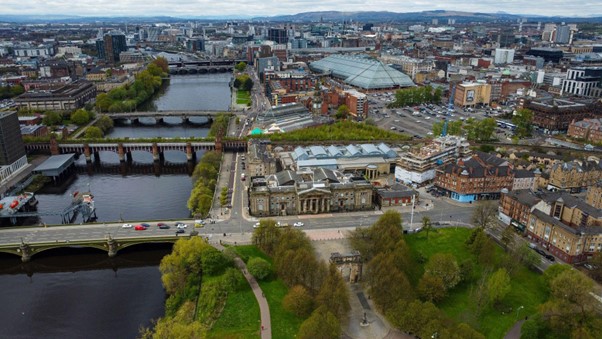
The Old Firm derby, which is contested between Celtic and Rangers, harks back to Glasgow’s past, and the bitterness between the two teams is rooted in history. Celtic fans are predominantly Catholics, many of whom have family who emigrated from Ireland, while the majority of Rangers fans are Protestants. The links with Northern Ireland and Rangers give them a British identity, while the links between the Republic of Ireland and Celtic give them a more Scottish or even Irish identity.
If history and football are your passions, then a visit to either Celtic Park or The Ibrox is a necessity when in Glasgow. Both stadiums are separated by just a 13-minute drive, so it’s definitely possible to visit both stadiums during a trip to Glasgow.
Tickets for both Celtic and Rangers are around the £30 mark and can be bought online or paid in cash at the stadium. This is fairly reasonable for the top flight of Scottish football when compared to the prices that some top and even second-division English teams charge.
Glasgow itself is absolutely worth a visit, football aside. While it’s often stereotyped as being the home of the deep-fried Mars Bar and other hugely calorific treats, the foodie scene in Glasgow goes far beyond Irn Bru and deep-fat fryers. It’s also home to some of the nicest coffee shops in Scotland – perfect for a quick pick-me-up before a Celtic or Rangers game.
Record Attendance: 83,500 (Celtic vs Rangers, 1st January 1938); 118,567 (Rangers vs Celtic, 2nd January 1939)
Stadium Capacity: 60,411 (Celtic Park); 51,587 (The Ibrox)
11. Rotterdam, Netherlands
Making the short trip across the North Sea, our next stop is in Rotterdam, in the central region of the Netherlands. By far, the biggest club in the city is Feyenoord, one of the giants in the Eredivisie, the Dutch top division. Feyenoord’s official stadium name is Stadion Feijenoord, but is better known by its nickname, De Kuip, which translates from Dutch to English as ‘The Tub’.
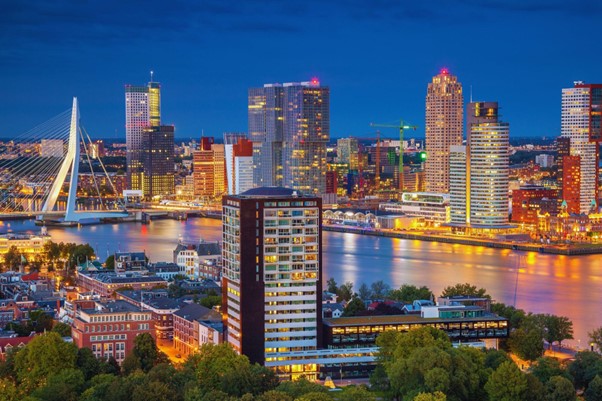
Feyenoord fans are known throughout Europe for their passion and devotion to their club, and they often sell out their allocated capacity for home and away matches, even when they travel throughout Europe in Champions League campaigns.
For football fans, a visit to Rotterdam is a must. The city is often overlooked in favour of Amsterdam, but it is incredibly easy to walk around, and the accommodation is often much more reasonably priced than in the country’s capital. Rotterdam, like much of the Netherlands, is very flat, so walking around the city is very easy, even for those with restricted mobility issues.
Record Attendance: 65,562 (9th January 1966, vs Ajax)
Stadium Capacity: 51,117
10. Leeds, England
The only city on this list whose football club plays in the Championship (the second division of English football), Leeds is nevertheless a fantastic city to visit for football fans.

Traditionally, Leeds was a huge club, that regularly won the Top Division, and had some fantastic players, such as England World Cup winners Jack Charlton and Norman Hunter, as well as names such as Robbie Fowler, Mark Viduka, Jimmy Floyd Hassebaink, Rio Ferdinand and more, who have all represented the famous white kit of Leeds United.
Leeds is also a popular city for students and is home to some of Yorkshire’s best nightlife. Alongside the night-time economy in the city growing, the foodie scene in Leeds has exploded in recent years, and the West Yorkshire city is home to some of the best pizza in the north – perfect for soaking up a few beers after a match at Elland Road!
Since the beginning of the 2024-25 season, Leeds United have capped ticket prices for away fans at £30, so if you manage to get a ticket in the away end at Elland Road, you can experience the fantastic atmosphere that is so associated with LUFC for less than the price of a home ticket.
Record Attendance: 57,892 (vs Sunderland, 15th March 1967)
Stadium Capacity: 37,792
9. Athens, Greece
We’ve already visited Rome, so it only makes sense to take a visit to Athens, right? Another city steeped in world history, and home to influential figures such as Aristotle, Plato, Socrates and more, Athens truly is a unique city.

From the epicentre of the Ancient World to the capital of the modern, urban nation of Greece, Athens is also home to two of southern Europe’s biggest football clubs: Panathinaikos and Olympiacos. Naturally, the two are fierce rivals on the football pitch, and they contest the Athenian derby, known as the ‘Derby of Eternal Enemies’.
The Greek league was typically regarded as a ‘retirement home’ for top European footballers who wanted an easy end to their careers while being able to bask in the Athenian sunshine during the off-season. However, this is not the case anymore. Multitudes of young footballers are sent on loan to Greece – usually to Panathinaikos and Olympiacos – to learn their trades in a physical league, backed up by thousands of passionate fans.
Ticket prices in Athens are some of the most reasonable in Europe – with matchday tickets at Panathinaikos starting from as little as €10 (£8.35), while the average price of a matchday ticket rarely exceeds €25 (£20.86) at Olympiacos.
Outside of football, Athens is known for its welcoming Greek hospitality, excellent food, and wide selection of beers and wines, making it the perfect city to visit for football fans.
Record Attendance: 74,493 (Panathinaikos vs AEK Athens, 21st December 1986); 45,445 (Olympiacos vs AEK Athens, 7th April 1965)
Stadium Capacity: 69,618 (Panathinaikos, Athens Olympic Stadium); 33,334 (Olympiacos, Karaiskakis Stadium)
8. Naples, Italy
It’s not surprising that another Italian city has made this list of the best European cities for football fans. Located on Italy’s southwestern coast, Naples is a wonderful city to visit – and is generally accepted as the birthplace of pizza, so even more reason to visit!
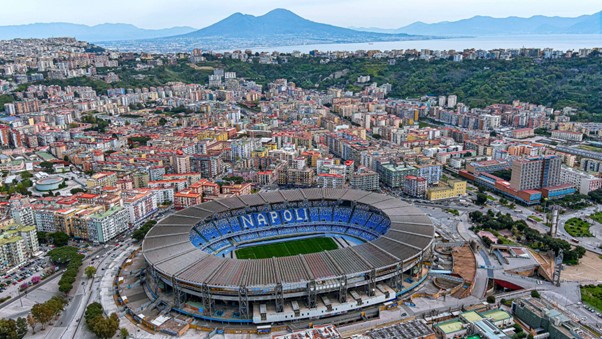
The city of Naples is also home to SSC Napoli, the city’s main football club, who compete in Serie A, alongside the other Italian clubs previously mentioned in this article.
Napoli plays their home matches at their stadium named after their most famous player – the Stadio Diego Armando Maradona. The stadium is easily accessible to fans who opt to use public transport, as there is a metro stop directly outside the stadium’s entrance. Fans can even arrive straight from Naples Train Station or Naples Airport and make their way directly to the stadium. Journeys take between 30 and 45 minutes, respectively.
As a city, Naples is a wonderful place to visit. As well as being able to sample some of the best pizza in the world, visitors to Napoli can also see the ancient and preserved city of Pompeii, as well as take a trip up the nearby Mount Vesuvius, the volcano responsible for Pompeii’s destruction in 79 CE.
Record Attendance: 90,736 (15th December 1974, vs Juventus)
Stadium Capacity: 54,725
7. Paris, France
The capital of France, the city of love, Paris has it all going on. And it is also home to one of the richest football clubs in the world: Paris Saint-Germain, better known as PSG.

As well as competing valiantly in the Champions League every season, PSG are often regarded as a team that is simply ‘too good’ for Ligue 1. They have won the Ligue 1 title an incredible 12 times, including the last three in a row, making them a formidable force in French football.
Many legendary players have passed through the ranks at PSG, including Brazilian superstars Ronaldinho, Neymar Jr and Thiago Silva, as well as other players such as David Beckham, Zlatan Ibrahimovic, Kylian Mbappe and more. PSG’s appeal as an international brand has helped its popularity explode in the last 20 years, and its home stadium, the Park des Princes, is an excellent place to visit and watch a match. The stadium also offers guided tours, where visitors can browse PSG’s incredible trophy cabinet, and dressing rooms, and see historic memorabilia at the same time. PSG also work closely with the Parisian community, and since 2000, the PSG Foundation has helped over 250,000 disadvantaged children and teenagers.
Of course, we all need little reason to visit Paris, because outside football it is one of the most beautiful cities in the world. It’s also a very family-friendly city, so well worth a visit if you are taking your children on holiday.
Record Attendance: 49,575 (vs Waterschei, 13th March 1983)
Stadium Capacity: 48,229
6. Amsterdam, Netherlands
The capital city of the Netherlands is home to numerous museums, cafes, bars, restaurants and also Ajax Football Club – the biggest club in the country.

Regular competitor in the Champions League, and 36-time Eredivisie winner, Ajax are one of the best clubs in Europe. They play in the arena named after their best player (and arguably the greatest Dutch player of all time), Johan Cruyff Arena.
The club itself is sometimes nicknamed ‘de Joden’, which translates from Dutch to English as ‘the Jews’, although this is not a name used in a derogatory manner. It actually harks back to the history of Ajax Football Club, when the stadium (during the 1930s) was located in Amsterdam’s Jewish Corner, so much of the fanbase was – and still is – Jewish.
Visitors to the Johan Cruyff Arena can also undertake tours of the stadium, with adult tickets being priced at €18 (£15.02) each – this includes a look at the pitch, commentary box, dressing rooms, trophy cabinet, memorabilia and more.
The Johan Cruyff Arena can be reached directly via train, taking 16 minutes from Amsterdam Centraal train station, or just 21 minutes from Amsterdam Schipol Airport.
Record Attendance: 55,076 (24th April 2024, vs Excelsior Rotterdam)
Stadium Capacity: 55,865
5. Manchester, England
No list of the best European cities for football fans is complete without mentioning Manchester – home to two of the biggest clubs in world football.

Both Manchester United and Manchester City play their football in Manchester and contest the highly-anticipated Manchester Derby in the Premier League every season. Since the inception of the Premier League in 1992, the Manchester clubs have won 21 of the possible 32 league titles between them, with United edging City by 13 to 8.
Manchester is also home to the National Football Museum, which aside from Old Trafford and the Etihad makes Manchester well worth visiting for fans of any football team.
Some of the best footballers of all time have played for these two Mancunian giants, including Sir Bobby Charlton, George Best, Wayne Rooney and Cristiano Ronaldo for United, while City have had world-class players such as Sergio Aguero, Colin Bell, Vincent Kompany and David Silva to name just a few. Both clubs are well-respected through their charity and community work, which has benefited those less fortunate residents of Manchester and its surrounding areas.
So whether you’re donning the red of United or the sky blue of City, either way, make sure to pay a visit to Manchester for your cultural fix at the same time.
Record Attendance: 76,098 (31st March 2007, Manchester United vs Blackburn Rovers); 54,693 (6th February 2016, vs Leicester City)
Stadium Capacity: 74,310 (Manchester United, Old Trafford); 53,400 (Manchester City, Etihad Stadium)
4. Belgrade, Serbia
Arguably the biggest footballing nation in the Balkans, Serbia is the home nation of Red Star Belgrade, who play their home games at the Rajko Mitić Stadium.
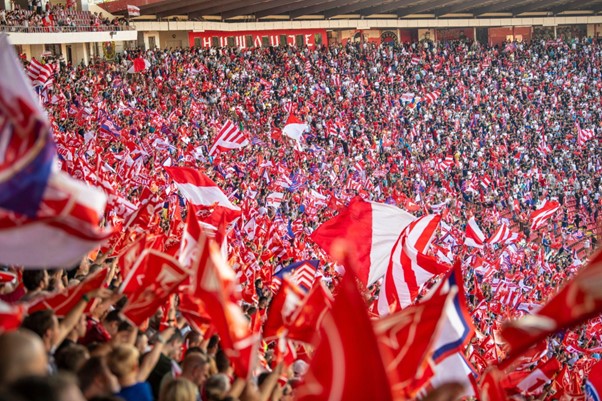
Although it has a tumultuous history, Belgrade is a city full of wonders and surprises, and it offers a remarkable cultural experience when visiting the former Yugoslav city. Home to some incredible bars, where you can get a wide selection of beers, wines and other drinks for very reasonable prices, it’s the perfect place for a pit stop en route to the Rajko Mitić Stadium.
The stadium itself is easily accessible, with many entrances and seating areas suitable for wheelchair users, meaning that their view of the pitch is not obstructed. The fans are passionate about their club, and come out in huge numbers to support Red Star throughout Europe. They also have the record of having the largest home attendance figure from any stadium in Europe, which was against Ferencváros, a Hungarian side, in 1975 when over 100,000 spectators turned up to watch the match – more than double the capacity of the stadium.
Belgrade is a must-visit for football fans, even just to experience the intense atmosphere that Red Star fans are renowned for creating – and although it can be intimidating, you can expect to see some of the best football in the Balkans on offer at the Rajko Mitić Stadium.
Record Attendance: 116,000 (23rd April 1975, vs Ferencváros)
Stadium Capacity: 53,000
3. Newcastle, England
The Magpies, as they are affectionately known (or less-affectionately as the Barcodes by rival fans) due to their iconic black and white stripes, Newcastle United are one of the biggest football clubs in England and the richest football club in the world.
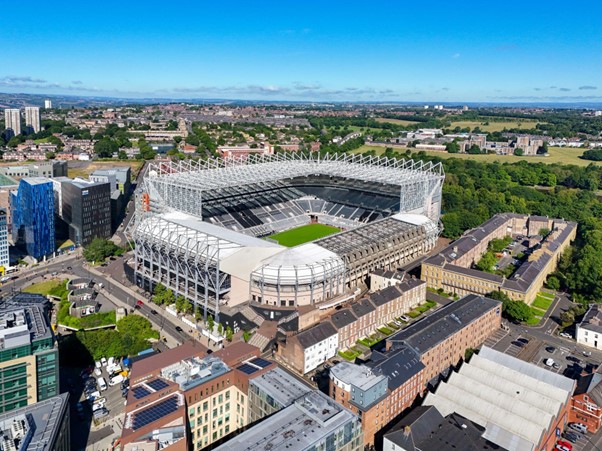
St James’ Park is the ground that Newcastle United call home, and they are famous for their huge fanbase and passionate supporters, who proudly call themselves the Toon Army. Newcastle city centre is also known for being quiet on Saturday afternoons during the football season, as well over 50,000 Geordies head to St James’ Park to cheer on Newcastle United, while many thousands more flock to pubs and clubs to watch the match.
Newcastle is a wonderful city for tourists to visit, and is incredibly popular with students, being home to both Newcastle University and Northumbria University. Thanks to its large student population (approximately 1 in 6 residents of Newcastle are students), there is lots on offer to do in the city, for football fans and non-football fans alike – such as visiting one of the city’s many stunning rooftop bars for a quick drink before the match. There is a metro station (aptly named St James’) located a stone’s throw from the ground, which gives visitors direct access to the stadium.
The Geordies are known for their welcoming demeanour and hospitality, so a visit to Newcastle is a must for any football fan – just don’t wear a Sunderland top!
Record Attendance: 68,386 (3rd September 1930, vs Chelsea)
Stadium Capacity: 52,350
2. Munich, Germany
Found in southern Germany, and the capital of the Bavarian region of the country is Munich. This historic city is home to Bayern Munich Football Club, one of the great European giants of football.
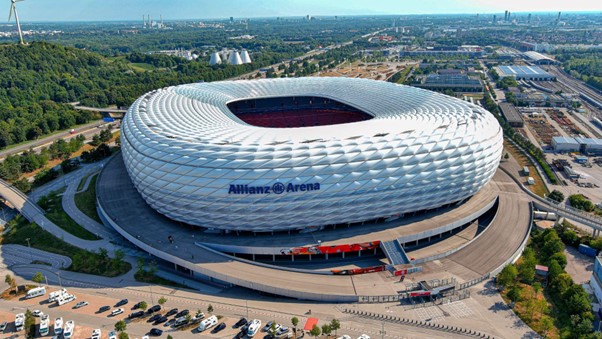
From their humble origins as Bavaria’s only professional football team to 32-time Bundesliga champions, Bayern Munich is, without doubt, one of the best teams in European football, and the city itself does not shy away from this.
The mighty Allianz Arena where Bayern Munich play their home matches stands proudly in the city centre, and if there’s anything that Bavaria is also known for, it’s a range of incredible food and drink – so you’ll never go hungry or thirsty if you are visiting Munich for a football match. Bavaria is also home to Bavarian beer – which can even be classed as a foodstuff, rather than a drink – find out all about that and more that Munich has to offer you here.
Incredibly, Bayern Munich, despite their huge stature as a giant of European football offers some of the cheapest tickets in Europe – with the very cheapest tickets available from just €5 (£4.17). Of course, these tickets are hard to get because they’re in such high demand, but there’s no harm in trying!
Record Attendance: 73,132 (19th April 1989, vs Napoli)
Stadium Capacity: 75,024
1. Madrid, Spain
Spain’s capital is arguably the best European city for football fans. Home to two Spanish teams – Real Madrid and Atlético Madrid – these rival teams regularly compete for the La Liga title, and are always ever-present in the Champions League, season after season.

Both Real Madrid and Atlético Madrid have had their fair share of world-class players: Fernando Torres, Antoine Griezmann, Diego Simeone and Juanfran have all donned the red, white and blue of Atlético, while Los Galacticos have seen players such as Zinedine Zidane, Roberto Carlos, Sergio Ramos, Alfredo Di Stéfano and more don the famous all-white strip of Real Madrid.
The Santiago Bernabéu and the Cívitas Metropolitano (Real Madrid and Atlético’s stadiums, respectively) can be reached within a 15-20 minute drive of each other, so visiting both stadiums is definitely possible on a trip to Madrid.
And making the most of this incredible city while you’re there is a must. The city itself is home to innumerable fantastic bars, restaurants, museums, art galleries and more, although if you opt to hire a car, you can also explore the surrounding areas of Madrid by road – which makes for a memorable and fun experience.
Record Attendance: 129,690 (19th April 1956, Real Madrid vs AC Milan); 69,500 (18th January 2024, Atlético Madrid vs Real Madrid)
Stadium Capacity: 85,000 (Santiago Bernabéu, Real Madrid); 70,460 (Cívitas Metropolitano, Atlético Madrid)